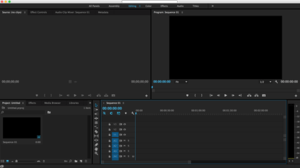Adobe Premiere Pro
|
| |
|
Adobe Premiere Pro CC running on OS X El Capitan | |
| Developer(s) | Adobe Systems |
|---|---|
| Stable release |
CC 2017 (11.0.0)
/ November 2, 2016[1] |
| Preview release | None [±] |
| Operating system | Windows 7 and later; OS X Yosemite and later[2] |
| Type | Video editing software |
| License | Trialware |
| Website |
www |
Adobe Premiere Pro is a timeline-based video editing software application. It is part of the Adobe Creative Cloud, which includes video editing, graphic design, and web development programs.
CNN was an early adopter of Adobe Premiere.[3] Also, in 2007, BBC adopted Premiere.[4] It has been used to edit feature films, such as Gone Girl,[5] Captain Abu Raed,[6] and Monsters,[7] and other venues such as Madonna's Confessions Tour.[8]
History
Premiere Pro is the redesigned successor to Adobe Premiere, and was launched in 2003. Premiere Pro refers to versions released in 2003 and later, whereas Premiere refers to the earlier releases. Premiere was one of the first computer-based NLEs (non-linear editing system), with its first release on Mac in 1991. Up until version Premiere Pro 2.0 (CS2), the software packaging featured a galloping horse, in a nod to Eadweard Muybridge's work, "Sallie Gardner at a Gallop".
Features
Premiere Pro supports high resolution video editing at up to 10,240 × 8,192[9] resolution, at up to 32-bits per channel color, in both RGB and YUV. Audio sample-level editing, VST audio plug-in support, and 5.1 surround sound mixing are available. Premiere Pro's plug-in architecture enables it to import and export formats beyond those supported by QuickTime or DirectShow, supporting a wide variety of video and audio file formats and codecs on both MacOS and Windows. When used with Cineform's Neo line of plug-ins, it supports 3D editing with the ability to view 3D material using 2D monitors, while making individual left and right eye adjustments.
Workflow integration
- After Effects
- Through Adobe Dynamic Link, compositions from Adobe After Effects may be imported and played back directly on the Premiere Pro timeline. The After Effects composition can be modified, and after switching back to Premiere Pro, the clip will update with the changes. Likewise, Premiere Pro projects can be imported into After Effects. Clips can be copied between the two applications while preserving clip attributes. Premiere Pro also supports many After Effects plug-ins.
- Photoshop
- Adobe Photoshop files can be opened directly from Premiere Pro to be edited in Photoshop. Any changes will immediately be updated when the Photoshop file is saved and focus returns to Premiere Pro.
- Adobe Story, OnLocation and Prelude
- The Premiere Pro workflow takes advantage of metadata in the script of a video production. The script is created in or brought into Adobe Story, then passed to Adobe OnLocation to capture footage and attach any relevant metadata from the script to that footage. Finally, in Premiere Pro, speech recognition can match the audio to the dialogue from the script in the metadata. Clips can be searched based on their dialogue in Premiere Pro, and can be sent to Adobe Encore to make searchable web DVDs. Adobe Prelude replaces OnLocation in CS6 and above.[10]
- Others
- There are other integration functions, such as Edit in Adobe Audition, Dynamic Link to Encore, and Reveal in Adobe Bridge.
Advantages over Premiere Elements
An entry-level version, Adobe Premiere Elements is aimed at home users available on Microsoft Windows and Mac OS X. With Premiere Pro aimed at the professional market, it has advantages over Premiere Elements including multiple sequence support, high bit-depth rendering, multicamera editing, time remapping, scopes, color correction tools, advanced audio mixer interface, and bezier keyframing. Premiere Pro also has Encore, for more elaborate DVD and Blu-ray Disc authoring options, and OnLocation for direct-to-disk recording. Encore was discontinued with the release of Adobe Creative Cloud.
Release history
| Version | Platform | Release date | Significant changes | Codename |
|---|---|---|---|---|
| Adobe Premiere 1.0 | Mac | December 1991[11] |
|
Demon |
| Adobe Premiere 2.0 | Mac | September 1992[13] | ||
| Adobe Premiere 3.0 | Mac | August 1993[15] |
|
|
| Adobe Premiere 1.0 | Windows | September 1993[16] |
Films edited on Adobe Premiere Pro
- 13 (by Burton Snowboards)[20]
- A Liar's Autobiography[21]
- Captain Abu Raed[6]
- Dust to Glory[22]
- Gone Girl[5]
- Monsters[7]
- TimeScapes[23]
- Red Obsession[24]
- Sharknado 2: The Second One[25]
- Staten Island Summer[26]
- Superman Returns (for the video capture process)[27]
- The Social Network (only conforming)[28]
- Ticket to Ride (by Warren Miller Entertainment)[29]
- Waiting for Lightning[30]
- Wayland's Song[31]
- We Will Part[32]
- World War II from Space[33]
- Hugo (only VFX work)[34]
- The Tourist
- Act of Valor[35]
- Avatar (daily and basic edits in conjunction with Avid)[36]
- Thunderbirds Are Go[37]
See also
- Adobe Premiere Elements
- Adobe Premiere Express
- Adobe Creative Suite
- Creative Cloud controversy
- List of video editing software
- Comparison of video editing software
References
- ↑ "Premiere Pro CC and Adobe Media Encoder CC - Creative Cloud blog by Adobe".
- ↑ "System requirements". Adobe Premiere Pro system requirements. Adobe Systems. Retrieved July 25, 2012.
- ↑ Foxton, Joe (October 25, 2013). "Editing Wars: Adobe Premiere vs Final Cut vs Avid". MediaSilo Blog. Retrieved May 27, 2014.
- ↑ "Adobe Creative Suite 3 Production Premium Wins in Broadcasting". Press Release. Adobe Systems. April 16, 2007. Retrieved May 2, 2008.
- 1 2 "David Fincher's new movie shot and post produced at 6K and used 36 TB of SSDs!", RedShark News, August 27, 2014, retrieved September 8, 2014
- 1 2 Frazer, Bryant (January 31, 2008). "Conforming a D-20 Feature in Adobe Premiere Pro". studiodaily.
- 1 2 "Monsters". Customer Stories: Video, Film, and Audio. Adobe Systems. January 14, 2011. Retrieved July 25, 2012.
- ↑ "Madonna's Confessions Tour Uses a Flexible, Fast HP Workstation". Digital Content Producer. August 2, 2006. Archived from the original on July 6, 2007. Retrieved July 6, 2007.
- ↑ "maximum dimensions in Premiere Pro CS5". Digital Video & Audio. Adobe Systems. July 20, 2010. Retrieved August 25, 2010.
- ↑ "Script-to-screen workflows". Adobe.com. Adobe Systems. Retrieved August 25, 2010.
- ↑ Sullivan, Eamonn (January 27, 1992). "Adobe multimedia tool makes nimble partner for QuickTime". PC Week. 9 (4). p. 34.
- ↑ Thompson, Tom (June 1992). "Two tools of the QuickTime trade". Byte. 17 (6). p. 336.
- ↑ Chadbourne, Teri (September 18, 1992). "Adobe Premiere Version 2.0 Now Available". Business Wire. New York.
- ↑ Green, Doug; Green, Denise (November 16, 1992). "Premier holds its place as the best multimedia editor". InfoWorld. 14 (46). pp. 142–144.
- 1 2 Pane, Patricia J. (August 2, 1993). "Adobe Premiere 3.0 for the Macintosh now available". Business Wire. New York.
- ↑ Peck, LaVon. "Adobe Premiere 1.0 for Windows now available", Business Wire, New York, 10 September 1993.
- ↑ Rosenbaum, Daniel J. (January 1992), "Premiere 1.0 for Windows: digital video production on the PC", Computer Shopper, 14 (1), pp. 869(2)
- ↑ Safi, Quabidur R. (October 11, 1993), "Premiere 1.0 for Windows", PC Week, 10 (40), pp. 92(1)
- ↑ Taft, Darryl K.; Georgianis, Maria V. (August 16, 1993), "Adobe builds presence across multiple platforms", Computer Reseller News (540), pp. 16(1)
- ↑ Charneco, Kathy (November 8, 2012). "Popular switches to Adobe Premiere Pro CS6 for latest Burton Snowboards film-"13"". Pro Video Coalition. Retrieved January 25, 2013.
- ↑ ""A Liar's Autobiography" Filmmakers Switch to All Adobe Workflow for Tribute to Monty Python Member", Pro Video Coalition, September 8, 2012, retrieved January 25, 2013
- ↑ "Adobe Premiere Pro used to Cut Dust to Glory", Digital Media Net, January 24, 2005, retrieved August 27, 2012
- ↑ "Tom Lowe breaks technological and creative bounds with TimeScapes", Pro Video Coalition, October 12, 2012, retrieved January 25, 2013
- ↑ ""Red Obsession" weaves intoxicating story", Pro Video Coalition, February 11, 2014, retrieved May 27, 2014
- ↑ "Sharknado 2 and Vashi's Premiere Pro Editorial Workflow", Pro Video Coalition, July 29, 2014, retrieved August 21, 2014
- ↑ "'Staten Island Summer'", Pro Video Coalition, August 14, 2015
- ↑ Restuccio, Daniel (June 1, 2006), "'SUPERMAN RETURNS'", Post
- ↑ "The Social Network: Friends of filmmaking" (PDF). Hollywood, California: Adobe Systems. October 15, 2010. Retrieved July 25, 2012.
- ↑ "The Black Diamond run for filmmakers", Pro Video Coalition, April 24, 2014, retrieved May 27, 2014
- ↑ "Lightning strikes with new Danny Way documentary created by Jacob Rosenberg", Pro Video Coalition, December 6, 2012, retrieved January 25, 2013
- ↑ "The Punk Rocker Who Became a Filmmaker", Pro Video Coalition, May 31, 2013, retrieved January 25, 2013
- ↑ "Filmmaking dreams realized", Pro Video Coalition, May 27, 2014, retrieved May 27, 2014
- ↑ "A bird's-eye view of World War II", Pro Video Coalition, October 2, 2013, retrieved May 27, 2014
- ↑ "HUGO: Filmmaking past informs filmmaking future" (PDF). Adobe Systems. February 28, 2012.
- ↑ "Bandito Brothers/Act of Valor: Larger than life" (PDF). Adobe Systems. February 28, 2012.
- ↑ "Avatar: the filmmaking future is now" (PDF). Adobe Systems. January 7, 2010.
- ↑ Keane, Megan (August 22, 2015). ""Thunderbirds" blasts back to the small screen". Digital Video & Audio Blog. Adobe Systems. Retrieved April 26, 2015.

